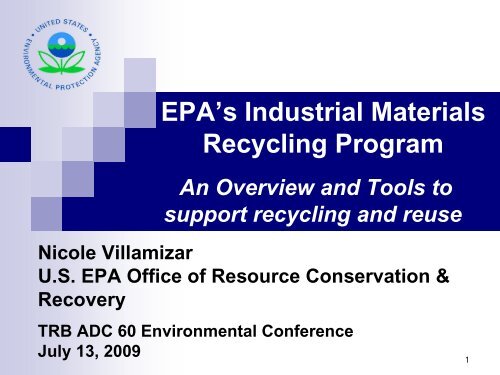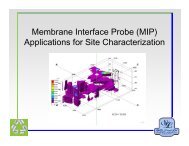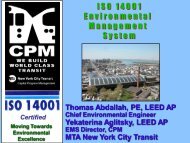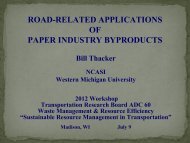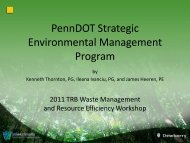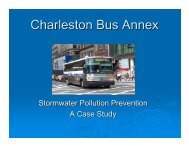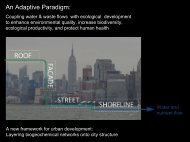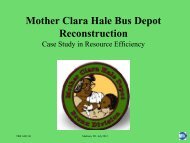EPA’s Industrial Materials Recycling Program
EPA Voluntary Programs & Initiatives - Trb-adc60.org
EPA Voluntary Programs & Initiatives - Trb-adc60.org
- No tags were found...
You also want an ePaper? Increase the reach of your titles
YUMPU automatically turns print PDFs into web optimized ePapers that Google loves.
<strong>EPA’s</strong> <strong>Industrial</strong> <strong>Materials</strong><br />
<strong>Recycling</strong> <strong>Program</strong><br />
An Overview and Tools to<br />
support recycling and reuse<br />
Nicole Villamizar<br />
U.S. EPA Office of Resource Conservation &<br />
Recovery<br />
TRB ADC 60 Environmental Conference<br />
July 13, 2009<br />
1
Overview<br />
• What are <strong>Industrial</strong> <strong>Materials</strong>?<br />
• Why use industrial materials in roadways?<br />
• What is the U.S. <strong>EPA’s</strong> <strong>Industrial</strong> <strong>Materials</strong><br />
<strong>Recycling</strong> (IMR) <strong>Program</strong>?<br />
• What are some challenges to increased use<br />
of industrial materials?<br />
• What are some key resources to support<br />
reuse?<br />
2
What are <strong>Industrial</strong> <strong>Materials</strong>?<br />
• Byproducts of industrial processes<br />
Coal combustion, metal casting, pulp and paper<br />
production, construction & demolition, etc.<br />
Over 500 million tons generated annually<br />
• <strong>Materials</strong> Include:<br />
CCPs; C&D materials, spent foundry sand<br />
Used tires, slag, silica fume<br />
3
Why use <strong>Industrial</strong> <strong>Materials</strong>?<br />
• Environmental Benefits<br />
Avoided impacts from processing of virgin<br />
materials (e.g. GHG emissions)<br />
• Economic Benefits<br />
Reduced costs associated with disposal<br />
Cost savings from use instead of more costly<br />
materials<br />
• Performance Benefits<br />
Perform as well as or better than traditional<br />
materials<br />
• Increased strength, improved workability,<br />
resistance to chemical attack; longer life<br />
4
What is the U.S. <strong>EPA’s</strong> IMR <strong>Program</strong>?<br />
• Part of the <strong>EPA’s</strong><br />
Resource Conservation<br />
Challenge (RCC), a<br />
national effort to conserve<br />
materials, save energy and<br />
reduce greenhouse gas<br />
emissions by managing<br />
materials more efficiently<br />
IMR is one of four priority areas of the RCC<br />
5
What is the U.S. <strong>EPA’s</strong> IMR <strong>Program</strong>?<br />
• Focusing on increasing the<br />
recycling of select materials:<br />
CCPs; C&D (asphalt, concrete),<br />
spent foundry sand; used tires, slag,<br />
silica fume, pulp and paper<br />
byproducts<br />
• Applications:<br />
Roadways, Transportation,<br />
Buildings, Agricultural<br />
www.epa.gov/industrialmaterials<br />
6
What is the U.S. EPA's IMR <strong>Program</strong>?<br />
• IMR program staff in each of 10 Regions<br />
7
What is the U.S. <strong>EPA’s</strong> IMR <strong>Program</strong>?<br />
IMR Focus areas<br />
1. Measurement and benefits<br />
2. Regulatory and safety issues<br />
3. Supporting developing markets<br />
4. Communications and benefits<br />
8
What is the U.S. <strong>EPA’s</strong> IMR <strong>Program</strong>?<br />
Key IMR <strong>Program</strong> Activities<br />
• The Construction Initiative<br />
Focuses on building/transportation projects<br />
Offers opportunities for public recognition through<br />
case studies and media events<br />
EPA staff and partners provide technical assistance<br />
• The Coal Combustion Products Partnership<br />
Collaborative program to promote sage and effective<br />
use of CCPs<br />
www/epa.gov/C2P2<br />
9
What is the U.S. <strong>EPA’s</strong> IMR <strong>Program</strong>?<br />
Key IMR <strong>Program</strong> Activities<br />
• Mid-Atlantic Green Highways Partnership<br />
Voluntary partnership among FHWA, EPA, state<br />
DEQs/DOTs, industry and others<br />
www.greenhighways.org<br />
• NEW! “Green Transportation and Construction<br />
Initiative” in New York, New Jersey<br />
Charles Harewood, U.S. EPA Region 2, will present<br />
Wednesday AM at TRB<br />
10
A few of <strong>EPA’s</strong> <strong>Industrial</strong> <strong>Materials</strong><br />
<strong>Recycling</strong> Partners<br />
• Federal Highway Administration (FHWA)<br />
Office of Pavement Technology<br />
• U.S. Department of Agriculture (USDA)<br />
Agricultural Research Service<br />
• National Association of County<br />
Engineers (NACE)<br />
• American Public Works<br />
Association (APWA)<br />
• Associated General Contractors of America<br />
(AGC)<br />
11
What are some challenges to use of<br />
industrial materials?<br />
• Approved materials and uses vary by<br />
state<br />
State solid waste regulatory agencies<br />
approve use and application for<br />
materials<br />
• Lack of approved transportation<br />
specifications for use of materials<br />
Some DOTs unfamiliar with materials;<br />
materials not specified (or even<br />
prohibited) in specs or contracts<br />
• Environmental risk concerns<br />
Perceived vs actual risks<br />
12
What are some key resources to<br />
address those challenges?<br />
• EPA/FHWA publications<br />
• Industry associations<br />
• Academic research centers<br />
• Existing specifications for<br />
industrial materials<br />
• State <strong>Program</strong> Highlights<br />
• EPA and FHWA staff<br />
13
Resources: Publications<br />
14
Publication highlights<br />
benefits, provides<br />
resources and<br />
references, such as<br />
ASTM specifications<br />
15
Resources: Industry Associations<br />
• The <strong>Industrial</strong> Resources Council (IRC)<br />
American Coal Ash Association<br />
Construction <strong>Materials</strong> <strong>Recycling</strong> Association<br />
Foundry Industry <strong>Recycling</strong> Starts Today<br />
National Council for Air and Stream<br />
Improvement<br />
National Slag Association<br />
Rubber Manufacturers Association<br />
Please visit: www.industrialresourcescouncil.org<br />
16
Resources: The Recycled <strong>Materials</strong><br />
• RMRC Goals:<br />
Resource Center<br />
Test, evaluate, develop appropriate guidelines (See:<br />
www.rmrc.unh.edu/tools/uguidelines/index.asp)<br />
Make information available to State transportation<br />
departments and other interested parties<br />
Analyze potential long-term considerations that affect<br />
the physical and environmental performance<br />
Work cooperatively with Federal and State officials to<br />
reduce the institutional barriers that limit widespread<br />
use<br />
Please visit: www.rmrc.unh.edu/<br />
17
Resources: Existing Specifications<br />
• Specs developed by the RMRC:<br />
Glass Cullet use for Soil Aggregate Base Course<br />
Reclaimed Concrete in Portland Cement<br />
Reclaimed Concrete in Granular Base<br />
Reclaimed Asphalt Shingles in Asphalt Concrete<br />
• AASHTO Specs:<br />
M295 – fly ash<br />
M302 - Ground granulated blast furnace slag<br />
18
Resources: State <strong>Program</strong> Highlights<br />
• Pennsylvania DOT<br />
Pollution Prevention Section, Strategic <strong>Recycling</strong><br />
program<br />
www.dot.state.pa.us/Internet/Bureaus/pdDesign.<br />
nsf/infoSpecifications?OpenForm<br />
• Texas DOT<br />
Specifications Using Recycled <strong>Materials</strong> by<br />
Application<br />
www.dot.state.tx.us/business/contractors_consult<br />
ants/recycling/speclist.htm<br />
19
Resources: People<br />
• <strong>EPA’s</strong> IMR <strong>Program</strong> Staff<br />
Staff in each EPA Region can assist you<br />
Send me an email and I’ll put you in touch<br />
with an EPA person in your area<br />
(villamizar.nicole@epa.gov)<br />
• Federal Highway Administration<br />
FALCON Team<br />
Focused on increasing use of recycled<br />
materials<br />
Contact: Jason Harrington<br />
(jason.harrington@dot.gov)<br />
• We want to highlight your great work!<br />
20
Summary<br />
• U.S. EPA is committed to increasing the<br />
recycling and beneficial use of industrial<br />
materials in an environmentally sound manner<br />
• Using recycled industrial materials in roadways<br />
makes good sense:<br />
Environmental benefits – supports GHG emission<br />
reductions – and key to reaching today’s state and<br />
local climate change policies<br />
Economic benefits – lower cost materials<br />
Performance – makes structures stronger, more<br />
durable<br />
21
Summary<br />
• While some challenges exist, there are<br />
organizations, people, and tools and<br />
resources to address those challenges<br />
EPA/FHWA programs and publications<br />
Industry and academic associations (RMRC)<br />
Existing specifications and model programs<br />
EPA and FHWA staff members!<br />
• EPA would like to highlight the great work<br />
you’re already doing through:<br />
Case studies, highlights on our website, press<br />
releases, etc.<br />
22
Thank you!<br />
Nicole Villamizar<br />
U.S. EPA Office Resource<br />
Conservation & Recovery<br />
(703) 347-8952<br />
Villamizar.Nicole@epa.gov<br />
23
Review of Key Websites<br />
• U.S. <strong>EPA’s</strong> IMR <strong>Program</strong>:<br />
www.epa.gov/industrialmaterials<br />
• Recycled <strong>Materials</strong> Resource Center:<br />
www.rmrc.unh.edu/<br />
• <strong>Industrial</strong> Resources Council:<br />
www.industrialresourcescouncil.org<br />
• FHWA Office of Pavement Technology:<br />
www.fhwa.dot.gov/PAVEMENT/recycling/index.c<br />
fm<br />
24


